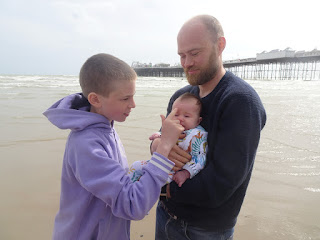A newly refurbished basketball court on Brighton Beach officially reopens today, following a major upgrade funded by Brighton & Hove City Council with support from Foot Locker and the Hoopsfix Foundation. The court has been extended in size and features a vibrant pink and blue design by Sam Sure of Half Decent Day. New equipment includes regulation-size Perspex backboards, spring-loaded rings, and a fresh playing surface with FIBA-standard markings.
The court’s relaunch (on this rather misty day) is being celebrated with a free public event, including coaching sessions for children, exhibition games, a slam dunk show, music, and giveaways, and will be followed by a new schedule of regular tournaments and competitions set to take place at the site (in partnership with Hoopsfix).The improvements were guided by a public consultation in which over 500 people participated. The overwhelming majority supported the upgrades, with 98% requesting new hoops and 86% asking for a larger court. In response, the court was lengthened by four metres and widened by two metres to better serve the growing number of basketball enthusiasts in the area.
Council leaders and project partners have praised the collaborative effort. Councillor Alan Robins said the court’s popularity reflects the national rise in basketball participation, especially among young people. Sam Neter of Hoopsfix described the court as one of the UK’s most iconic.
Brighton’s most prominent basketball connection is the Brighton Bears. Originally established in 1973, the team became a powerhouse in British basketball, playing under the Brighton Bears name until 1984 before relocating to Worthing and becoming the Worthing Bears. The team returned to Brighton in 1999, competing at the Brighton Centre - just a short walk from the beach - and quickly re-established itself as a top-flight team in the British Basketball League (BBL).
Under the leadership of coach Nick Nurse, who later led the Toronto Raptors to an NBA championship, the Bears enjoyed a successful run from 2001 to 2006, winning the BBL Championship in the 2002-03 season and the BBL Cup in 2004-05. It gained international attention in 2006 by signing NBA Hall of Famer Dennis Rodman for a brief stint. The franchise folded later that year, and efforts to revive elite basketball in Brighton faced challenges, with the BBL favouring Worthing Thunder for a franchise slot. However, the Bears’ legacy lives on through a new club established in 2014 in nearby Lancing, West Sussex, initially called the Sussex Bears but since 2022 known again as the Brighton Bears. See also Wikipedia.














